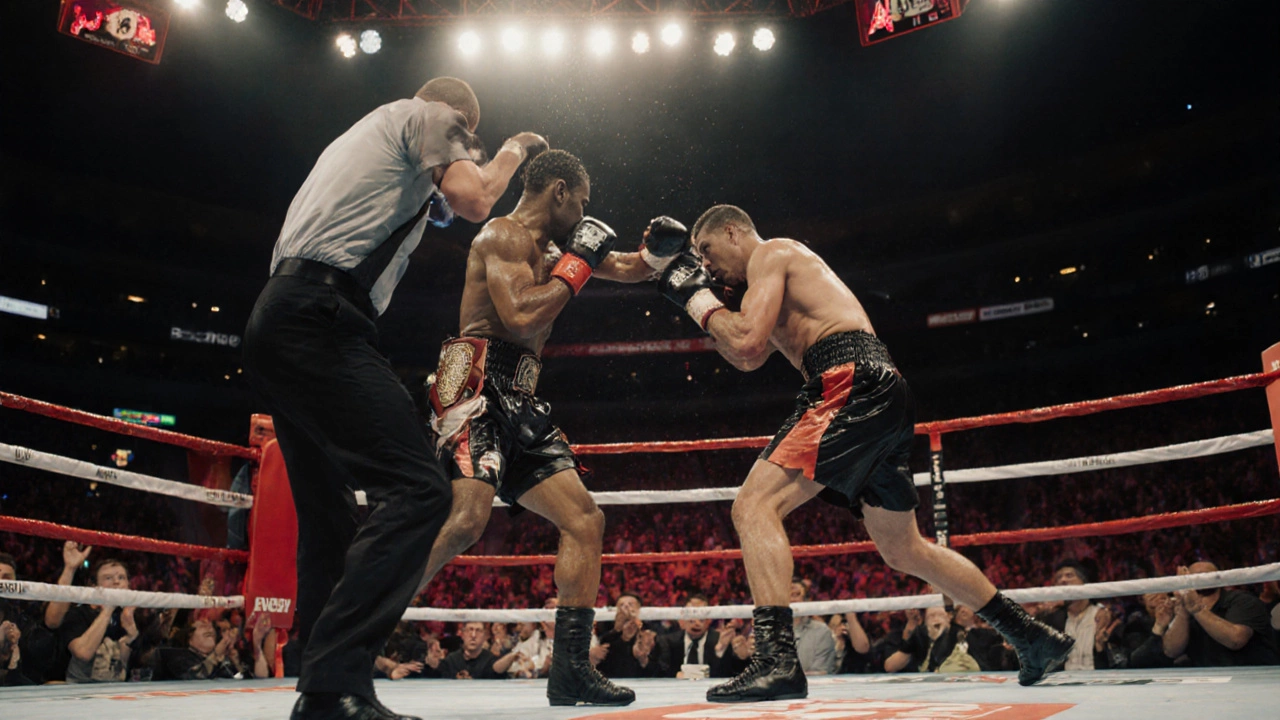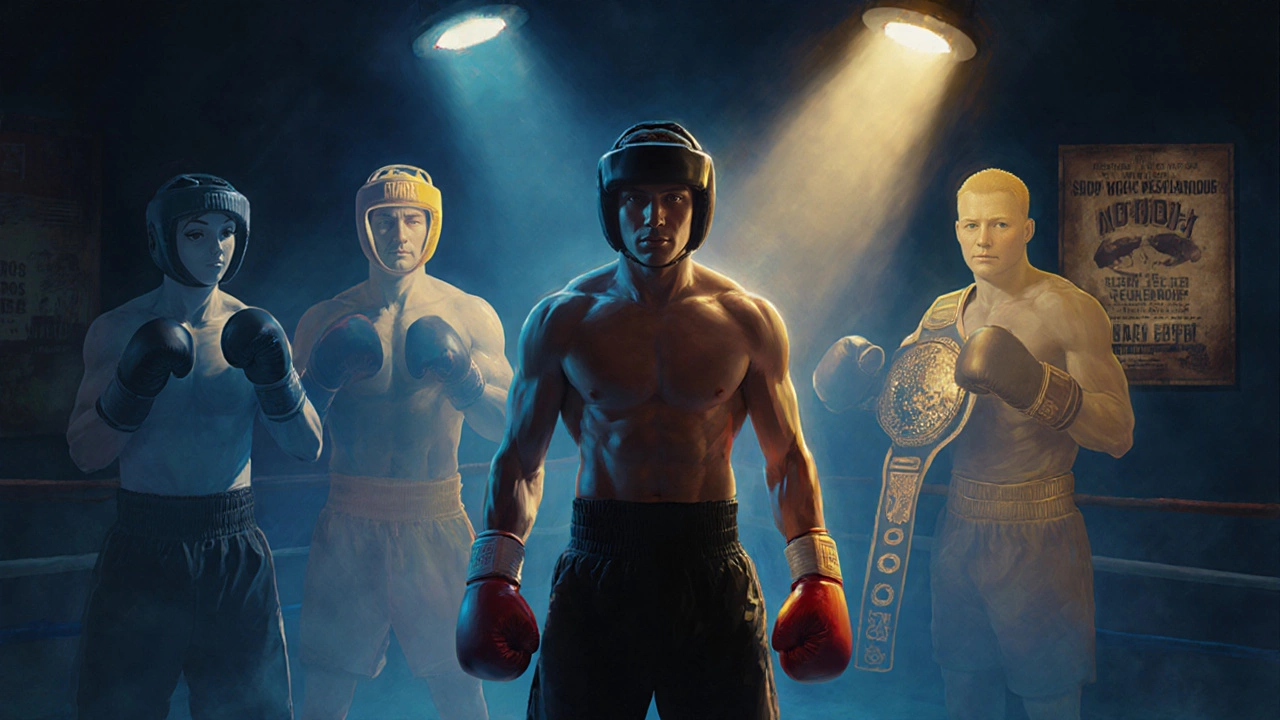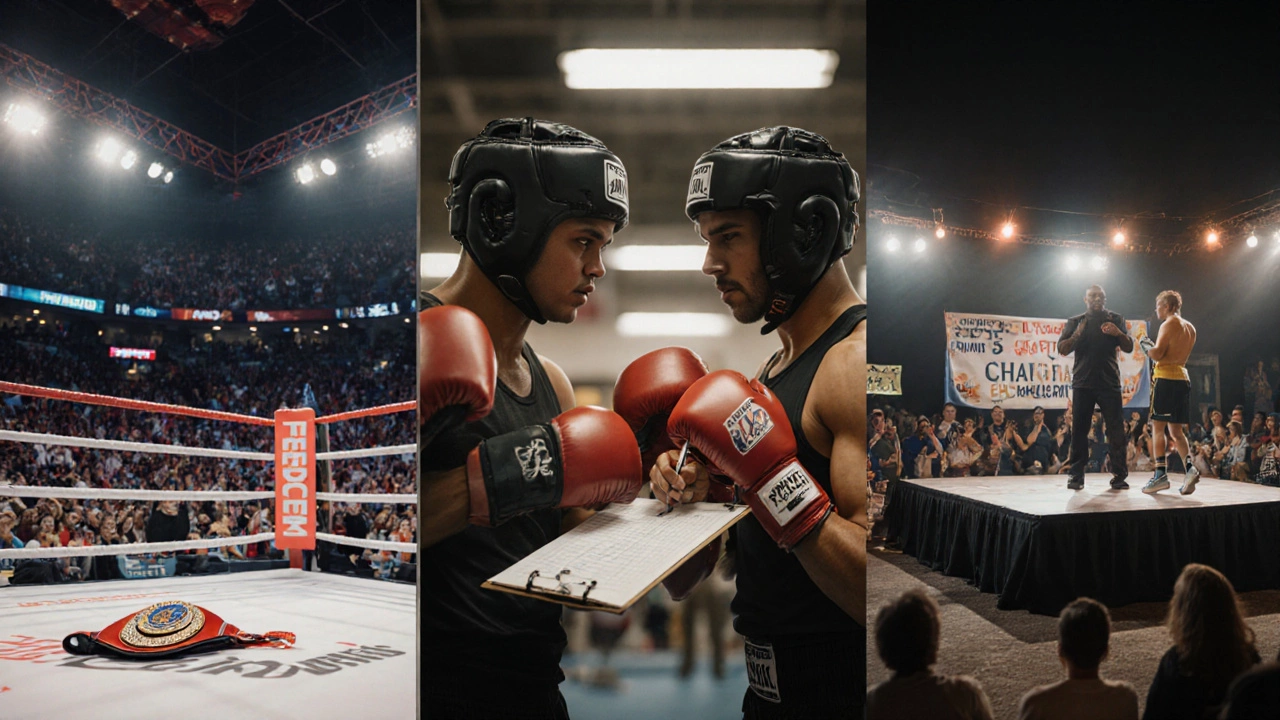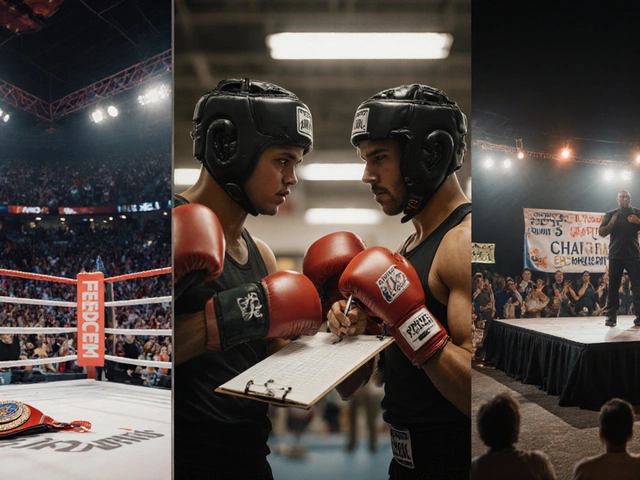Boxing Match Type Identifier
Common Boxing Match Types
Professional
4-12 rounds, 3 min each, 8-10 oz gloves, 10-point must scoring
Amateur
3 rounds, 2 min each, 10-12 oz gloves, point-per-punch scoring
Olympic
3 rounds (men), 4 rounds (women), 3 min (men), 2 min (women), 10-12 oz gloves
Exhibition
2-4 rounds, 2-3 min each, 12-16 oz gloves, no scoring
Sparring
2-3 rounds, 2 min each, 14-18 oz gloves, no scoring
Title Fight
12 rounds minimum, 3 min each, 8-10 oz gloves, 10-point must scoring
Ever wondered how many different kinds of boxing matches exist and why they feel so different? Whether you’re a fan trying to follow a night of fights, a newcomer stepping into the gym, or a casual viewer curious about the buzz, knowing the distinct match types helps you decode the rules, the stakes, and the vibe of each bout.
Key Takeaways
- Boxing matches fall into three broad families: professional, amateur (including Olympic), and exhibition/sparring.
- Each family has its own round length, glove size, scoring method, and governing body.
- Title fights, undercard bouts, and main‑event clashes are categories defined by the event’s hierarchy, not by the rules themselves.
- Understanding these differences lets you pick the right fights to watch, train for, or bet on.
Below we break down every major type you’ll see on a fight card, compare their core attributes, and answer the most common follow‑up questions.
1. The Big Picture: Three Main Families
The boxing world groups matches into three primary families:
- Professional matches - where athletes earn a purse, fight for rankings, and chase world titles.
- Amateur matches - the stepping‑stone for young talent, governed by national federations and featuring shorter rounds.
- Exhibition & sparring sessions - low‑stakes bouts used for entertainment, charity, or training purposes.
Within each family you’ll also find sub‑categories that describe the event’s role (e.g., title fight vs. undercard) or the competition’s scale (tournament vs. single bout).
2. Professional boxing match is a sanctioned bout where fighters compete for prize money and rankings under professional rules
Professional bouts are what you see on pay‑per‑view nights, at venues like Madison Square Garden or the O2 Arena. Key attributes:
- Rounds: 4 to 12, each lasting three minutes, with one‑minute rest intervals.
- Glove size: 8-10oz for heavier divisions, 10-12oz for lighter weight classes.
- Scoring: 10‑point must system - the winner of a round gets 10 points, the loser 9 or fewer.
- Sanctioning bodies: WBA, WBC, IBF, WBO, among others.
- Stakes: Prize money, rankings, title belts, and often media hype.
Because money and reputation are on the line, pro fights usually feature more elaborate production, stricter medical checks, and higher‑profile referees.
3. Amateur boxing match is a competition governed by national federations, focusing on skill development and point scoring rather than knockout power
Amateur bouts are the proving ground for future pros. They differ in several ways:
- Rounds: Typically 3 rounds of two minutes each (some youth leagues use 1‑minute rounds).
- Glove size: 10-12oz, often with more padding to reduce injury risk.
- Scoring: Point‑per‑punch system (now largely merged with the 10‑point system in elite competitions) - judges award a point for each clean, scoring blow.
- Governing bodies: International Boxing Association (AIBA), national federations, and Olympic committees.
- Stakes: Medals, scholarships, and a pathway to the professional ranks.
Amateur fights emphasize speed, technique, and defense. Headgear used to be mandatory but was removed for elite men’s competitions in 2013 to align closer with professional standards.

4. Olympic boxing bout is the premier amateur event held every four years, featuring the world’s top amateur boxers representing their nations
The Olympics are a special subset of amateur boxing. Distinguishing factors:
- Rounds: 3 rounds of three minutes (women’s bouts are 4 rounds of two minutes).
- Scoring: 10‑point must system, with judges focusing on clean hits, number of punches landed, and dominance.
- Gloves: 10oz for men, 12oz for women.
- Venue: Large, multi‑sport Olympic arenas under the International Olympic Committee’s oversight.
- Impact: Olympic medals dramatically boost a boxer’s marketability and fast‑track them to lucrative pro contracts.
Because the Olympics occur only once every four years, the competition is fierce and national pride adds extra pressure.
5. Exhibition match is a non‑competitive bout arranged for entertainment, charity, or promotional purposes, often with modified rules
Exhibition bouts are the “show‑time” side of boxing. They can feature retired legends, cross‑sport challenges, or celebrity participants. Typical characteristics:
- Rounds: 2 to 4 rounds, sometimes even a single five‑minute round.
- Glove size: Larger gloves (12-16oz) to reduce impact.
- Scoring: Usually no official scoring - the referee may stop the fight early for safety.
- Regulation: Often overseen by local athletic commissions, but the stakes are lower.
- Purpose: Fundraising, fan engagement, or testing a potential matchup before a full‑scale professional fight.
Fans love exhibitions because they’re relaxed, fun, and sometimes feature dream matchups that would never happen in a pro setting.
6. Sparring session is a controlled practice bout used by boxers to hone technique, timing, and conditioning
Sparring isn’t a “match” in the competitive sense, but it’s a critical match‑type that every boxer experiences. Key points:
- Rounds: Usually 2‑minute rounds, with a few rounds per session.
- Glove size: 14-18oz training gloves, providing extra padding.
- Scoring: None - the focus is on skill development, not winning.
- Supervision: Always overseen by a qualified coach or trainer to keep it safe.
- Goal: Build muscle memory, test new combinations, and gauge conditioning before a real fight.
Even world champions spend weeks sparring with partners that mimic upcoming opponents’ style.
7. Title fight is a high‑stakes professional bout where a championship belt is contested
Title fights sit at the top of the professional hierarchy. They differ from regular pro bouts in three ways:
- Rounds: Must be at least 12 rounds for world titles (though some regional titles use 10).
- Promotion: Heavier marketing budgets, press conferences, and sometimes a “pay‑per‑view” price tag.
- Sanctioning: The bout must be approved by the governing body that owns the belt (WBC, WBA, etc.).
Winning a title can instantly raise a fighter’s earning potential and legacy.

8. Undercard match is a supporting bout on a fight card that takes place before the main event
Undercard fights are the warm‑up act. They help build the audience’s excitement and give rising stars exposure. Typical traits:
- Length: Often 4‑6 rounds, but can be full‑length if a title is on the line.
- Visibility: Broadcast on secondary channels or streamed live.
- Purpose: Showcase prospects, settle regional disputes, or provide a “stepping‑stone” to a main‑event slot.
Many champions first made a name on undercards before graduating to headline the show.
9. Main event is the headline bout of a fight card, usually featuring the biggest names or title fights
The main event is the centerpiece that sells tickets. Its hallmarks:
- Position: Last bout of the night, often preceded by a “co‑main event”.
- Stakes: Usually a title fight, a high‑profile rivalry, or a cross‑weight showdown.
- Coverage: Prime‑time TV slots, extensive media hype, and larger purses for the participants.
Fans often remember a night by the main event, even if they watched the undercard for free.
10. Comparison of Common Match Types
| Match Type | Typical Rounds | Round Length | Glove Size | Scoring System | Primary Goal |
|---|---|---|---|---|---|
| Professional | 4‑12 | 3min | 8‑10oz (heavy) / 10‑12oz (light) | 10‑point must | Win purse & title |
| Amateur | 3 | 2min | 10‑12oz | Point‑per‑punch / 10‑point | Medal / experience |
| Olympic | 3 (men) / 4 (women) | 3min (men) / 2min (women) | 10oz (men) / 12oz (women) | 10‑point must | National glory |
| Exhibition | 2‑4 | 2‑3min | 12‑16oz | None (fun) | Entertainment / charity |
| Sparring | 2‑3 (practice) | 2min | 14‑18oz | None | Skill development |
| Title Fight | 12 (world) | 3min | 8‑10oz | 10‑point must | Championship belt |
11. How to Choose the Right Match Type for You
Whether you’re picking a fight to watch or deciding how to train, ask yourself these three questions:
- What’s my goal? If you’re after pure competition and a paycheck, go pro. If you want skill building and a pathway to the pros, join an amateur club.
- How much time can I commit? Pro fights demand long‑term contracts and intense camps. Amateur bouts require fewer weeks of preparation.
- What risk level am I comfortable with? Sparring and exhibitions prioritize safety, while title fights accept higher injury risk for bigger rewards.
Most fans will enjoy a mix: watch a title fight on TV for drama, then catch a local amateur tournament for raw talent. Boxers generally start with sparring, move to amateur bouts, and only after years of seasoning step into the professional arena.
Frequently Asked Questions
What is the main difference between a professional and an amateur boxing match?
Professional matches typically have longer rounds (3 minutes), more rounds (up to 12), smaller gloves, and a 10‑point must scoring system focused on overall performance. Amateur bouts use shorter rounds (2 minutes), fewer rounds (usually 3), larger gloves, and a point‑per‑punch or 10‑point system that rewards clean, scoring blows over power.
Can an Olympic boxing bout be considered professional?
No. Olympic boxing is strictly an amateur competition, even though the rules now mirror professional scoring. Athletes retain amateur status until they sign a professional contract.
Why do exhibition matches use larger gloves?
Larger gloves (12‑16oz) add padding that reduces impact, making exhibitions safer for participants who may not be in full fight shape. This also lowers the chance of accidental knockouts, keeping the event entertaining rather than dangerous.
What does “undercard” mean and why is it important?
The undercard is the series of bouts that happen before the main event. It gives up‑and‑coming fighters exposure, helps fill the event’s runtime, and builds audience excitement leading up to the headline fight.
How does scoring differ in a title fight versus a regular pro bout?
The scoring system itself (10‑point must) is the same, but title fights often have more judges (sometimes five instead of three) and stricter scrutiny from the sanctioning body. A single point swing can decide a championship, so judges tend to be more meticulous.
Now you’ve got the full rundown of every major boxing match type out there. The next time you see a fight card, you’ll know exactly what each bout represents, how it’s scored, and why it matters. Happy watching - and if you’re stepping into the ring, choose the match type that matches your goals and stay safe!

